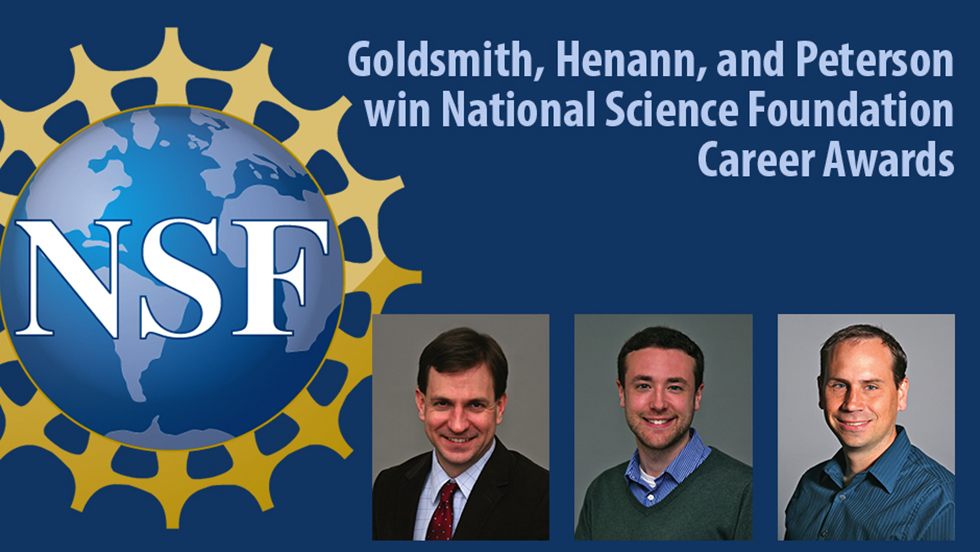 Franklin Goldsmith, David Henann, and Andrew Peterson have each received NSF Career Awards of approximately $500,000 over five years. Approximately one third (16 of 50) of the current Brown School of Engineering faculty has now won the award.
Franklin Goldsmith, David Henann, and Andrew Peterson have each received NSF Career Awards of approximately $500,000 over five years. Approximately one third (16 of 50) of the current Brown School of Engineering faculty has now won the award.
"The NSF Career Awards will provide vital research funding for these three assistant professors as they launch their research programs," said Larry Larson, Sorensen Family Dean of Engineering.
Peterson's award of $500,001 is for "Accurate Electrochemical Barriers Accelerated by Machine-learning." The study will promote advances in theoretical understanding of electrocatalysis as accelerated by machine-learning tools. The resulting understanding will aid the development of related technologies such as solar-fuel devices, batteries, fuel cells and electrolyzers - all of relevance to renewable energy and the commercialization of sustainable technologies. The research will also provide educational opportunities to students at various levels in both the U.S. and in rural Kenya, and will facilitate introduction of high-fidelity, accelerated atomistic calculations across a broad research community via the principal investigator's publicly available code, "Amp".
Henann's award of $507, 834 is for a continuum model for simultaneous prediction of granular flow and size-segregation in general geometries. The goal of his project is to develop a theoretical model that describes the behavior of flowing granular materials. Granular materials are ubiquitous - they include naturally-occurring materials such as sand, soil, and snow, as well as industrial and agricultural materials such as pharmaceutical pills and capsules, food grains, and catalyst particles. Predicting the behavior of these materials during flow poses special challenges, especially when the granular material consists of particles of different sizes. In this case, the flow causes the particles to segregate according to size, which, in turn, affects the flow of the material as a whole. The theory developed in this project will use nonlocal modeling to describe a representative granular material consisting of particles of two different sizes - called bidisperse. The resulting model will predict the flow behavior of this bidisperse system in several prototype flow geometries, and the results will be compared with corresponding experiments conducted as part of the project. A variety of educational activities are also planned, including the development of new modules illustrating computational methods in solid mechanics. The project will enlist undergraduates to participate in the research, and workshops will be conducted to disseminate results and engage broad technical communities.
Goldsmith's award of $500,000 over five years is to research "Fuels, Additives and Emissions in Low-Temperature Combustion." Low-temperature compression-ignition engines represent a new class of internal combustion engines that could meet the stringent and imminent fuel economy requirements. Engineers typically add additives to the fuel to improve the engine performance. The most commonly used additive contains nitrogen, yet the fate of fuel-bound nitrogen in low-temperature combustion is poorly understood. Although some of the ultimate combustion byproducts formed by nitrogen-containing additives in these engines may be comparatively benign, other byproducts are highly toxic, and the relative yield of these toxic byproducts is not known. The goal of this research is to discover the fate of fuel-bound nitrogen in advanced engines. Over the course of five years, Goldsmith will combine novel experimental, theoretical, and modeling techniques to provide quantitative measurements and kinetic predictions for the combustion byproducts of nitrogen-containing additives under engine-relevant conditions. This research will provide engineers with the tools to quantify the interactions between additives and transportation fuels in internal combustion engines, and to predict how changes to the additive, the fuel, or the engine will affect the emissions. Additionally, this research will benefit atmospheric chemists by improving their forecasts of smog and related problems. Finally, Goldsmith will develop a series of educational modules that illustrate how changing the structure of a fuel changes its combustion properties, and will create hands-on design projects in which students build different combustion devices.